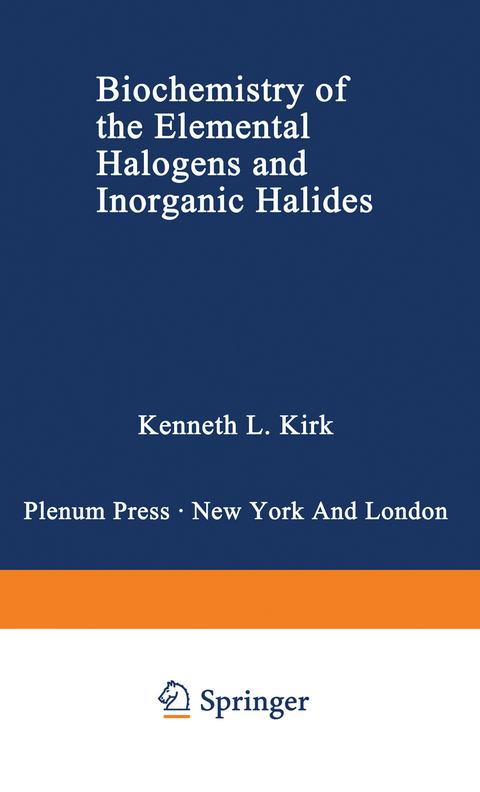
Biochemistry of the Elemental Halogens and Inorganic Halides
Kluwer Academic/Plenum Publishers (Verlag)
978-0-306-43653-6 (ISBN)
- Titel z.Zt. nicht lieferbar
- Versandkostenfrei innerhalb Deutschlands
- Auch auf Rechnung
- Verfügbarkeit in der Filiale vor Ort prüfen
- Artikel merken
1. The Halogens: Discovery, Occurrence, and Biochemistry of the Free Elements.- 1.1 Introduction.- 1.2 Fluorine.- 1.3 Chlorine.- 1.4 Bromine.- 1.5 Iodine.- 1.6 Summary.- 2. Biochemistry of Inorganic Fluoride.- 2.1 Introduction.- 2.2 Occurrence and Distribution of Inorganic Fluoride.- 2.3 Biological Uptake, Distribution, and Metabolism of Inorganic Fluoride.- 2.4 Overview of Effects of Fluoride on Enzyme Activity.- 2.5 Inhibition of 2-Phospho-D-Glycerate Hydrolase (Enolase).- 2.6 Inhibition of Inorganic Pyrophosphatase.- 2.7 Inhibition of Acetylcholinesterases and Butyrylcholinesterase.- 2.8 Inhibition of (Na+ + K+)-Dependent ATPase (ATP Phosphohydrolase) by Fluoride—Influence of Aluminum.- 2.9 Stimulation of ATP Pyrophosphate-Lyase (Cyclizing) (Adenylate Cyclase).- 2.10 Stimulation of Photoreceptor Phosphodiesterase I by Fluoride.- 2.11 Stimulation of Polyphosphoinositide Phosphodiesterase by Fluoride.- 2.12 Additional Regulatory Proteins That Interact with Fluoride.- 2.13 Effects of Fluoride on Cellular Function.- 2.14 In Vivo Toxicity of Fluoride.- 2.15 Effects of Fluoride on Mineralized Tissue.- 2.16 Biochemistry of Inorganic Fluoride—Summary.- 3. Biochemistry of Inorganic Chloride.- 3.1 Introduction.- 3.2 Transport of Chloride Through Cell Membranes.- 3.3 Chloride Transport and Body Fluid Homeostasis.- 3.4 Chloride/Bicarbonate Cotransport in Erythrocyte Membrane.- 3.5 Chloride/Cation Cotransport and Cell Volume Control.- 3.6 Chloride and Transepithelial Transport.- 3.7 Epithelial Chloride Secretion and Cystic Fibrosis.- 3.8 Hydrochloric Acid Secretion in the Stomach.- 3.9 Glycine- and Gaba-Gated Chloride Channels.- 3.10 Stimulation and Inhibition of Enzymes by Chloride.- 3.11 Chloride and Neutrophil Function.- 3.12 Biochemistry of Chloride—Summary.- 4.Biochemistry of Inorganic Bromide.- 4.1 Introduction.- 4.2 Occurrence and Biodistribution of Bromide.- 4.3 Pharmacology and Toxicology of Bromide.- 4.4 Bromide and Anion Transport Mechanisms.- 4.5 Inhibition and Stimulation of Enzymes by Bromide.- 4.6 Bromide and Eosinophil Function.- 4.7 Biochemistry of Bromide—Summary.- 5. Biochemistry of Inorganic Iodide.- 5.1 Introduction.- 5.2 Occurrence, Uptake, and Biodistribution of Iodide.- 5.3 Iodide Transport into Thyroid and Other Iodide-Concentrating Tissues.- 5.4 Stimulation and Inhibition of Enzymes by Iodide.- 5.5 Biochemistry of Inorganic Iodide—Summary.- 6. Iodotyrosine, Iodothyronines, and Thyroid Function.- 6.1 Iodotyrosine as a Biological Tracer.- 6.2 Iodothyronines and Thyroid Function.- 7. Biohalogenation.- 7.1 Introduction.- 7.2 Naturally Occurring Halometabolites.- 7.3 Haloperoxidases.- 7.4 Biosynthesis of Halometabolites in Marine Organisms.- 7.5 Biological Fluorination.- 7.6 Biohalogenation—Summary.- 8. Persistent Polyhalogenated Compounds: Biochemistry, Toxicology, Medical Applications and Associated Environmental Issues.- 8.1 Introduction.- 8.2 Biochemistry and Toxicology of Chlorinated Insecticides.- 8.3 Biochemistry and Toxicology of Halogenated Biphenyls, Terphenyls, Naphthalenes, Dibenzodioxins, and Related Compounds.- 8.4 Medical Applications of Halogenated Hydrocarbons.- 8.5 Summary.- 9. Metabolism of Halogenated Compounds—Biodehalogenation.- 9.1 Biodehalogenation—Introduction.- 9.2 Metabolism of Halogenated Alkanes.- 9.3 Metabolism of Halogenated Alkenes.- 9.4 GSH-Dependent Metabolism and Toxicity of Halogenated Alkenes.- 9.5 Metabolism of Halogenated Aromatic Compounds.- 9.6 Biodehalogenation Mediated by Microorganisms.- 9.7 Metabolism and Biodehalogenation—Summary.
| Reihe/Serie | Biochemistry of the Elements ; 9A+B |
|---|---|
| Zusatzinfo | 312 p. |
| Sprache | englisch |
| Themenwelt | Medizin / Pharmazie ► Medizinische Fachgebiete ► Pharmakologie / Pharmakotherapie |
| Medizin / Pharmazie ► Pharmazie | |
| ISBN-10 | 0-306-43653-1 / 0306436531 |
| ISBN-13 | 978-0-306-43653-6 / 9780306436536 |
| Zustand | Neuware |
| Haben Sie eine Frage zum Produkt? |
aus dem Bereich


